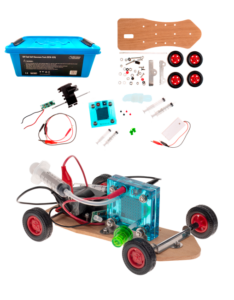H2 Grand prix XPR
The H2GP EXPLORER (XPR) program introduces elementary and middle school students to the basic science and engineering principles needed to understand sustainability and renewable energy. This program allows students to design & build their own fuel cell-powered vehicles using recycled materials.
H2GP XPR allows students to design & build their own fuel cell-powered vehicles using recycled materials. Use any material that you find at home or in the classroom – paper roll, PET bottle, piece of plywood, etc. – and create your own custom-made chassis. Then mount a fuel cell and create your own fuel cell powered car.
Then organize your class competition in your school gym and compare the team’s unique solutions. Invite teams from other classrooms or from schools in your neighborhood.
Programa Educativo:
Phase 1: Exploring Energy Sources
Climate change and renewable energy
Through its broad spectrum and developed curriculum, the H2GP XPR will easily fit in Chemistry, Physics, as well as Art or Ecology classes. Beyond the knowledge, students’ competencies will be effectively taught and developed through effective SEL principles. Finally, students are taught about renewable energy, why is it important and how to use recycled materials, so they can fully understand the importance of sustainability and the 3Rs: reduce-reuse-recycle.
Students analyze the difference between non-renewable and renewable energy, such as solar, wind, hydro, biomass, geothermal, and most of all hydrogen. They will understand why it is so crucial to promote sustainability by pursuing new green energy sources, utilize recycled materials, and see themselves are part of a larger global community. We strive to translate the well-known motto: “Think Globally, Act Locally” into every lesson!
Climate Change
Examine the evidence for global climate change and its effects on humans worldwide.
Renewable Energy Solutions
Explore the benefits and limitations of different types of renewable energy resources.
Energy Storage
Compare the energy storage capabilities of an electrolyzing fuel cell and a battery.
Phase 2: Hands-On Experience
DESIGN! BUILD! RACE
Thanks to the hands-on experience, there are plenty of ways for budding talent to be engaged through play! A future designer might be most comfortable with sketching, whereas aspiring engineers will enjoy the manufacturing part of the car. Analytical students will enjoy the data collection and assessment which will be very valuable for future prototypes. No matter from what perspective they start, all of them will bring their piece of the puzzle while working in small groups, where they’ll learn how to communicate, coordinate and compromise to get the optimal solution.
Students will also learn how to organize their time and gain valuable project management skills by learning to prioritize tasks in preparation for testing their designs. After the final race, students are encouraged to measure the traveled distances, examine their cars, take notes, and find out why some cars traveled further than others. This will in turn help them explore ways how to improve their designs and make them more effective.
“There is a long way to go from improving a small toy car design to improving the world, but this activity can become the crucial first step on the journey towards forming a better, cleaner future.”
Equipment
Horizon Educational has developed special STEAM-based equipment that introduces elementary and middle school students to basic science and engineering principles together with sustainability and renewable energy awareness.
Our kit includes instructions and all necessary parts to assemble a functioning hydrogen car. Once your students familiarize themselves with the technology, encourage them to build their own car from scratch and then use the Fuel Cell and motor to power it. Let them become engineers and designers of their own unique vehicle! How much imagination do they have? H2 Grand prix XPR H2 Grand prix XPR
